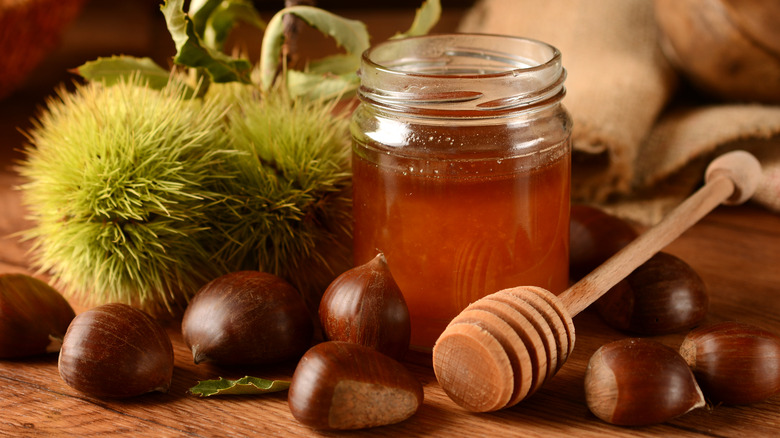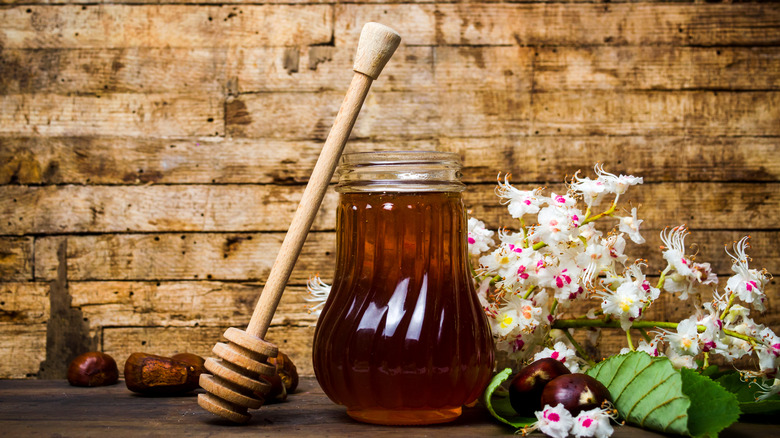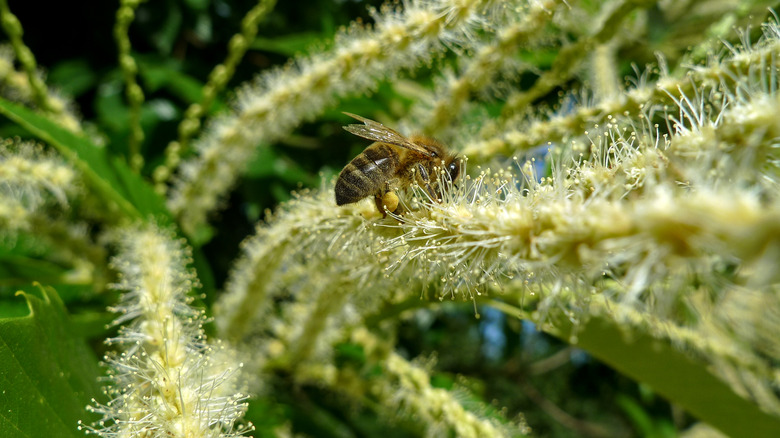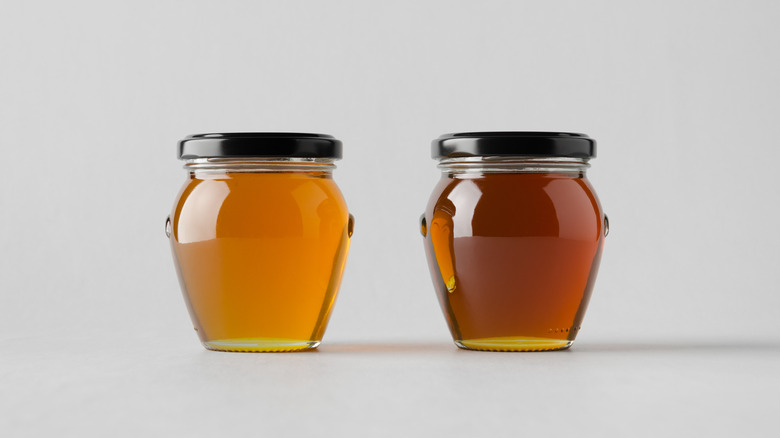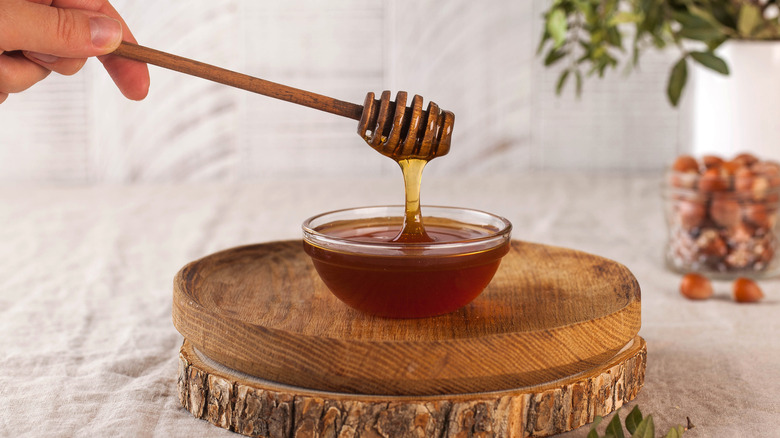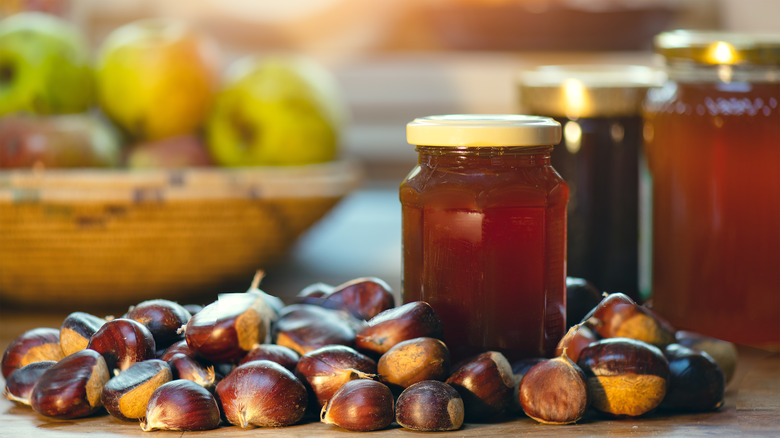Chestnut Honey: The Smoky Ingredient Your Pantry Is Missing
Chestnuts are a longstanding staple in Italian cuisine. Sweet chestnut trees are native to the Mediterranean and the northern coast of Asia. These large trees can prevail in regions where the soil is too spare for grains. Their availability made chestnuts an important source of food as far back as the Roman Empire.
What started out of necessity has evolved into tradition. Today, chestnuts can be found in many classic European dishes. Roasted chestnuts are popular in Italy, a sweet chestnut paste is used as a filling for pastries in Switzerland, and in Corsica, Chestnut flour is processed with malt and barley to make a local beer. But the chestnuts themselves aren't the only product of this local crop. Each summer, the bees that feed on chestnut tree blossoms produce a unique, bitter chestnut honey. Chestnut honey is a classic product of Tuscany, but it is also produced in France and Spain.
What is chestnut honey?
Chestnut honey is a dark, thick honey known for being smoky and complex, with slight notes of leather and wood. It's much less sweet than clover honey, and has a strong, distinctive flavor. It also contains naturally occurring tannins which give the honey a noticeably bitter, lingering finish.
This nuanced flavor profile makes chestnut honey extremely useful in the kitchen. It's the perfect ingredient for those who prefer desserts that aren't too sweet. Using it in place of clover honey will add rich complexity, as well as a touch of sweetness, to cakes, pies, or cookies. Chestnut honey is also an excellent addition to marinades, where its naturally smoky flavor will complement any protein. In Italy, chestnut honey is a classic pairing not only with Pecorino Romano and fruit, but also alongside other cheeses. Unlike clover honey, which can be easily overwhelmed by strong flavors, the bittersweetness of chestnut honey has the power to hold its own, even when paired with the most pungent stilton or gorgonzola.
If you love the bitter notes in this honey, you can even use it to sweeten tea. Its strong, tannic flavor makes it better suited to black teas, as it may overpower the subtle flavor of herbal teas.
How is chestnut honey made?
Chestnut honey is made using the same process as clover honey, but it differs in taste and appearance due to the diet of European honeybees. It's considered a monofloral honey, which means that the bees who produce it feed almost entirely on nectar from sweet chestnut tree blossoms. The unique taste and deep amber color of chestnut honey come from the distinct flavor of the chestnut tree blossoms.
The bees that produce this honey get to work in the summer when the trees are in bloom — between June and July— and the honey is harvested in the following months. The honey's flavor can be influenced by the weather during the season, so no two years will yield exactly the same product. Growing conditions can vary between regions, even if they're close together. Elements like microclimates, soil composition, or nearby geographical features will influence the trees enough to cause subtle differences in the flavor of chestnut honey. The location of the hive also makes a difference. Bees do most of their foraging within 3 kilometers of the hive, making this a hyper-local product
Chestnut honey vs clover honey
Clover honey is by far the most commonly available honey in the U.S., made by bees that primarily feed on clover nectar. It has a sweet and mild flavor with a delicate floral aroma. However, the quality of clover honey varies widely, with inexpensive options available in grocery stores and more flavorful raw or artisanal versions sold at farmer's markets and health food stores. It's worth noting that the term "clover honey" doesn't provide much detail about how the honey was produced since there are over 300 species of clover.
In contrast, European chestnut honey is always produced from the region's sweet chestnut tree (Castanea sativa). Chestnut honey is generally much harder to find compared to clover honey, which has a range of mass-produced options available. Chestnut honey is considered a regional delicacy, which is why it is challenging (but not impossible) to come by.
Chestnut honey nutrition
Honey is a natural sweetener that has a rich nutritional profile, unlike plain table sugar. Although it is high in simple sugars, honey also contains many vitamins and minerals. Chestnut honey, for example, is particularly rich in minerals such as potassium, calcium, and manganese, as well as vitamins B and C. According to reports published by the National Institute for Health, honey also has natural antibacterial properties that can be used to heal infected wounds and has been known to help build one's resistance to seasonal allergies. This is because when bees harvest nectar, they also collect small amounts of pollen, which ends up in unfiltered versions of the honey. Consuming local pollen can help train the immune system.
To reap the benefits of chestnut honey's nutritional power, look for unfiltered, unpasteurized honey. Pasteurization is a process that uses heat to kill active yeast cells in a food product. This treatment can prolong shelf-life, but critics say that pasteurization depletes honey's natural health benefits. Completely unpasteurized honey will specify "raw" on the label.
Where to buy chestnut honey
Chestnut honey is a specialty ingredient that you won't find on the shelves at major supermarkets. Shopping at an Italian grocery store or checking out an imported goods store is a better bet. If you don't have a local Italian market, don't despair. Shopping online has made obtaining even the most regionally specific ingredients possible. You can order chestnut honey directly from small producers like Borgo de'Medici or from major online markets.
Look for raw chestnut honey with a rich color—the darker the honey, the more intense and concentrated the flavor will be. The label will tell you where the honey was produced. Be sure to take note of the country of origin before you purchase because no two kinds of chestnut honey are exactly alike — to experience how much local environments can influence the flavor of honey, try ordering varieties produced in two different regions. You may be surprised by how much the taste can vary.
